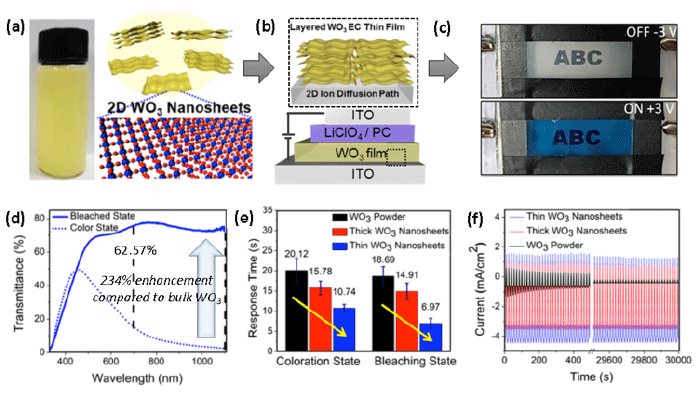Professor Seokwoo Jeon and his research team are working on the development of the two-dimensional (2D) WO3 nanosheets for high-performance electrochromic (EC) devices. Two-dimensional WO3 nanosheets are one of the best possible candidates for high-performance EC devices, due to higher surface area of the active material and extraordinary color-contrast. However, unlike other layered materials such as graphite or transition metal chalcogenides, exfoliation of 2D WO3 from the bulk WO3 counterpart is not successful because of the strong atomic bonding in the out-of-plane direction in the WO3 crystal system. The absence of direct exfoliating methods of 2D WO3 nanosheets from bulk WO3 materials limits the use of such materials.
Herein, the research team demonstrated a novel strategy for solution phase synthesis of highly-crystalline and high-aspect-ratio 2D WO3 nanosheets through sequential exfoliation and oxidation of layered WS2 powders for the first time. The water dispersed 2D WO3 material can easily be coated on a conducting substrate to fabricate high-performance EC devices in a cost-effective manner for commercialization. From a performance point of view, 2D WO3 nanosheets EC device showed color modulation 3.43 fold higher (62.57% at 700 nm wavelength), while also showing ∼46.62% and ∼62.71% faster switching response-time (coloration and bleaching), compared to the value of the conventional device using bulk WO3 powder. Extraordinary device performance was shown by 2D WO3 nanosheets because of fast electrolyte ion diffusion through more accessible 2D permeable channels, created by thin nanosheets of the device. Furthermore, the 2D WO3 nanosheet EC device also showed exceptional stability, with no significant fading of capacitance after 1000 cycles, proving robustness to the developed EC device.

Finally, in a broader scope, this work has unveiled a guideline for synthesizing two-dimensional transition metal oxides (WO3, MoO3, TiO2, and so on) for application to high-performance EC devices, as well as a potential wider range of electrochemical and optoelectronics applications.
Prof. Seokwoo Jeon (Department of Materials Science and Engineering)
Mr. Ashraful Azam (Department of Materials Science and Engineering)
Homepage: http://fdml.kaist.ac.kr
E-mail: jeon39@kaist.ac.kr, ashraful@kaist.ac.kr






